
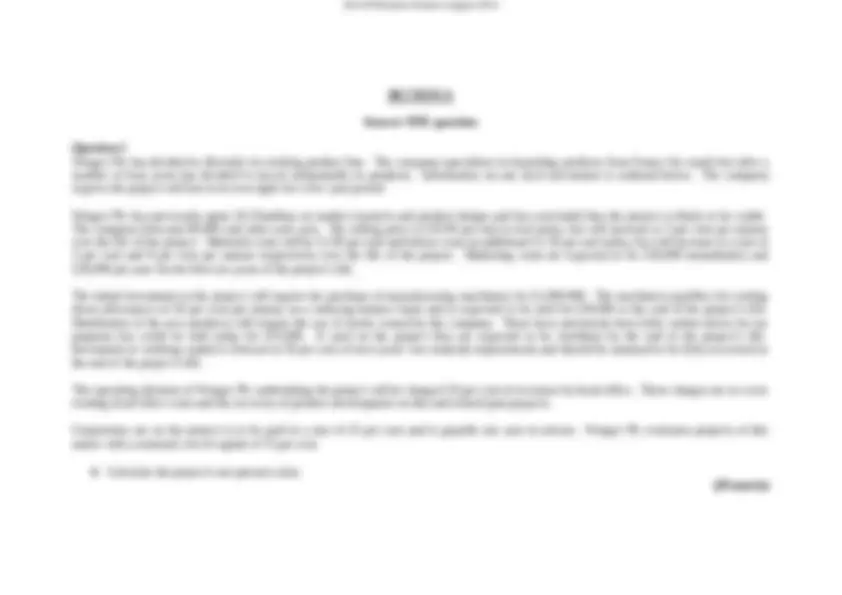
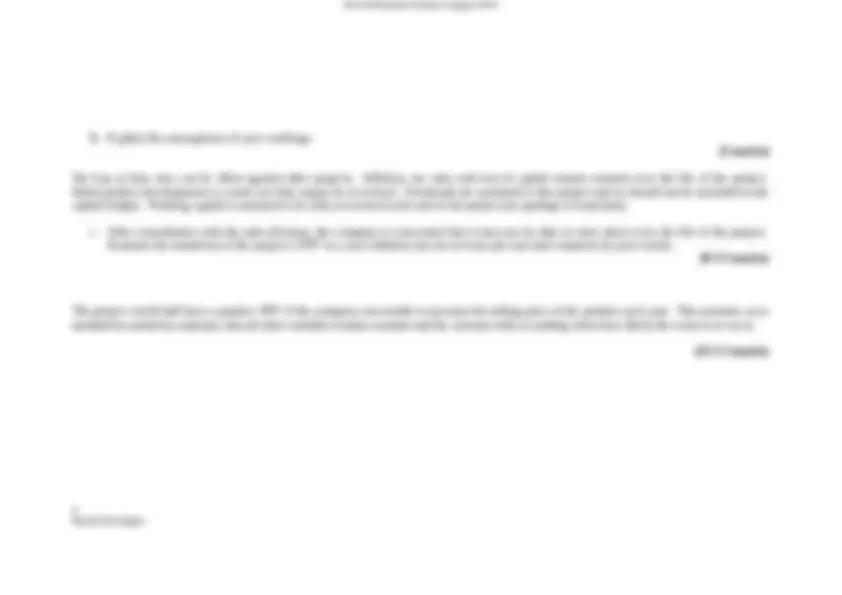
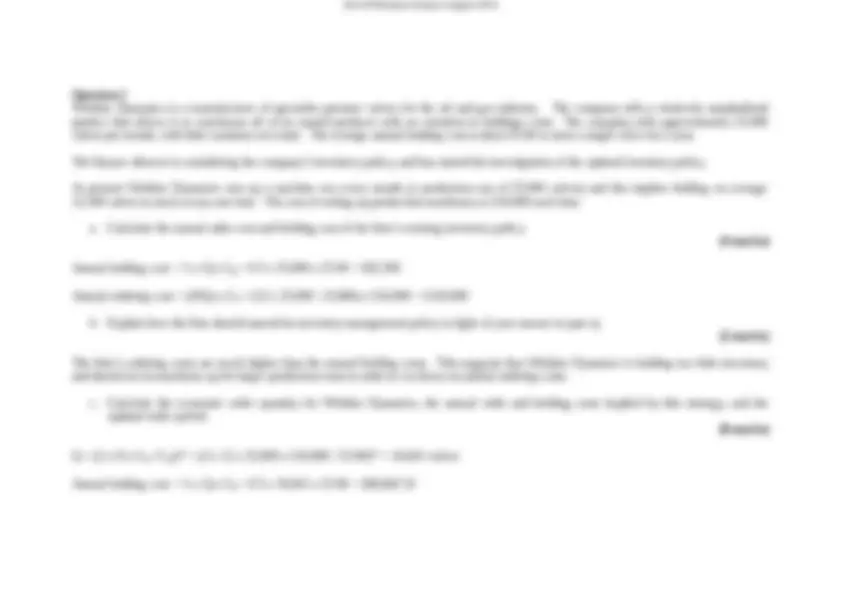

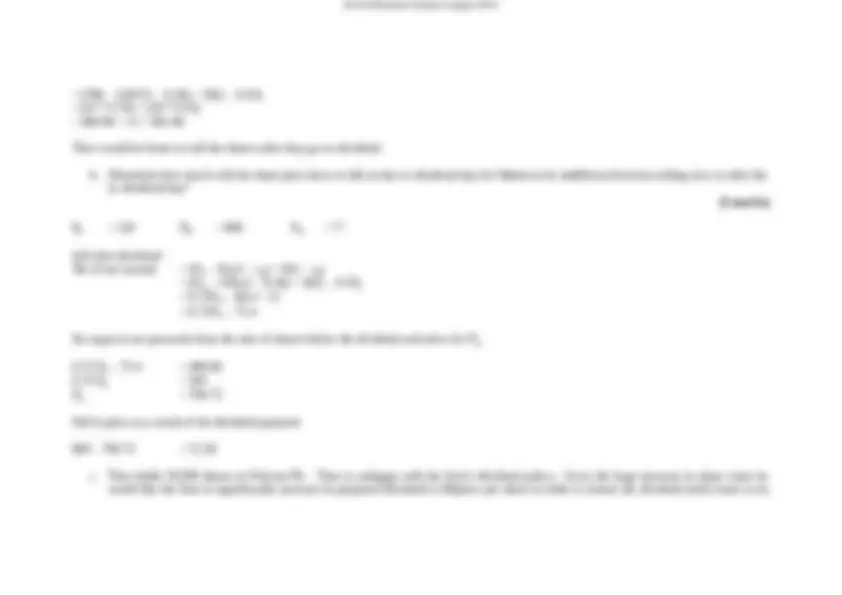
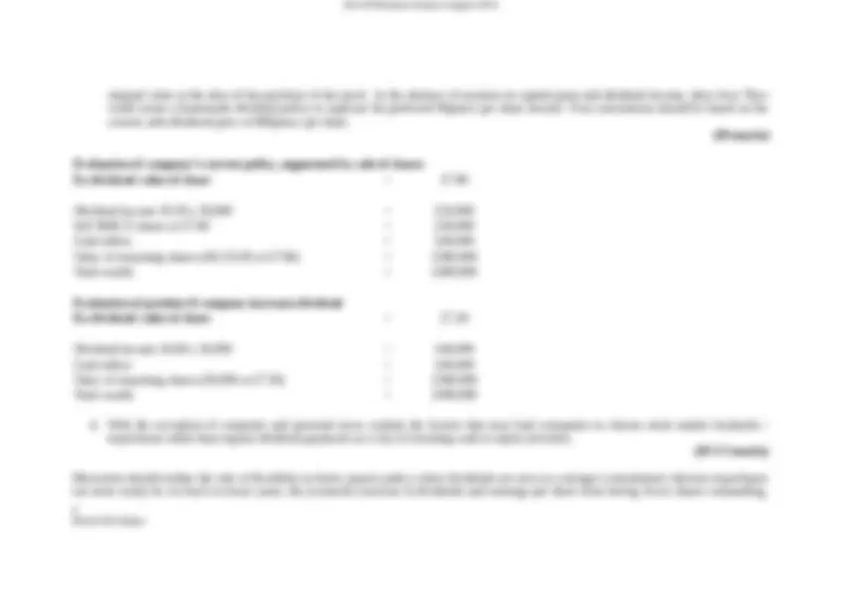
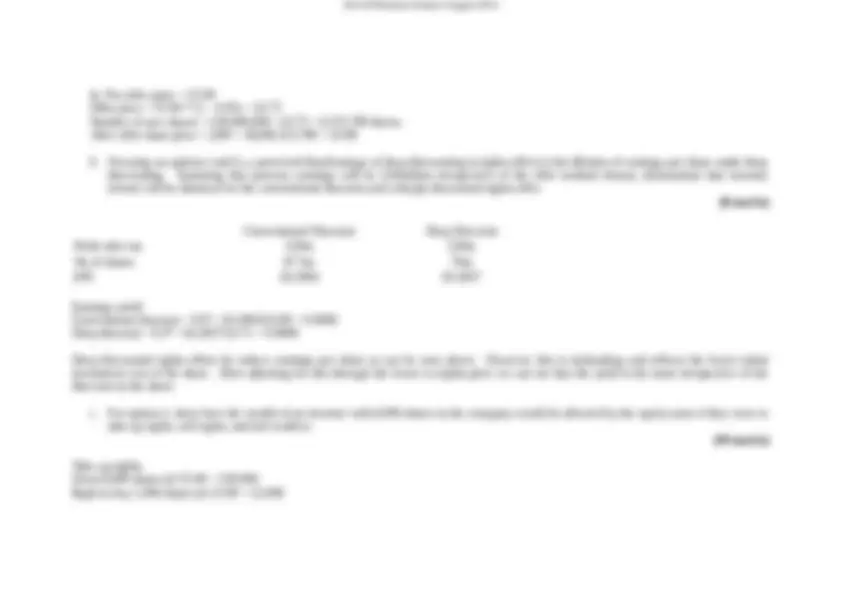
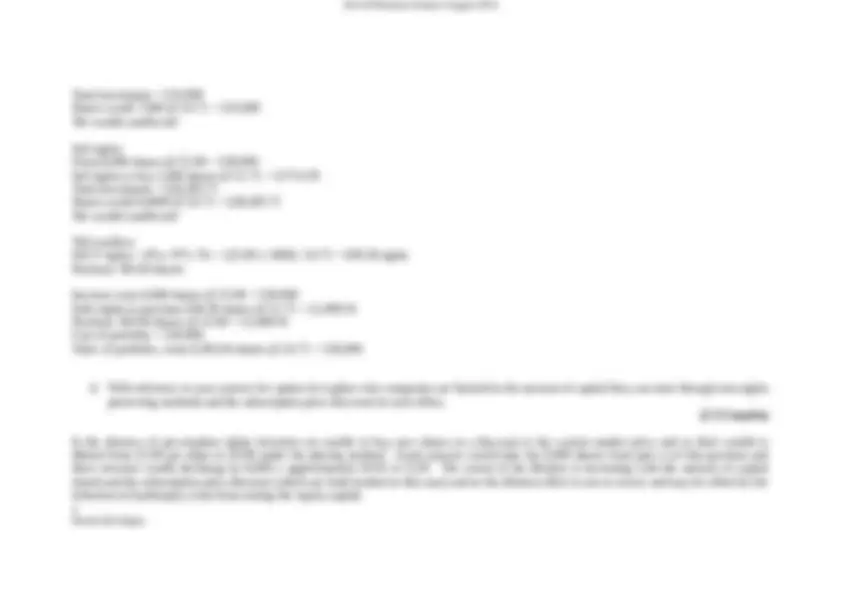
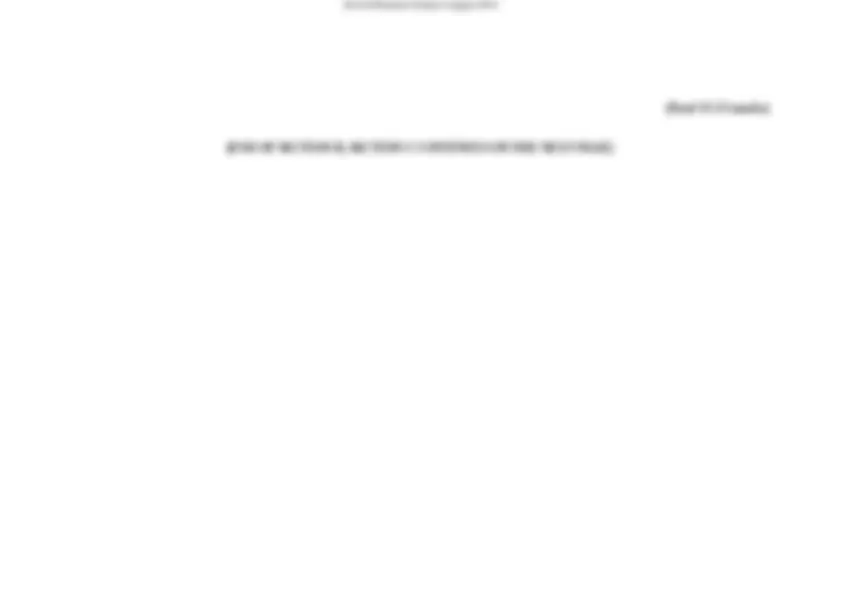







Study with the several resources on Docsity

Earn points by helping other students or get them with a premium plan


Prepare for your exams
Study with the several resources on Docsity

Earn points to download
Earn points by helping other students or get them with a premium plan
Community
Ask the community for help and clear up your study doubts
Discover the best universities in your country according to Docsity users
Free resources
Download our free guides on studying techniques, anxiety management strategies, and thesis advice from Docsity tutors
AG210_August_2014Solutions.docx AG210_August_2014Solutions.docx
Typology: Exercises
1 / 22

This page cannot be seen from the preview
Don't miss anything!















Calculators must not be used to store text and/or formulae nor be capable of communication. Invigilators may require calculators to be reset
4 Patrick McColgan
b. Explain the assumptions of your workings. (5 marks)
Tax loss at time zero can be offset against other projects. Inflation, tax rates and cost of capital remain constant over the life of the project. Initial product development is a sunk cost that cannot be recovered. Overheads are unrelated to this project and so should not be included in the capital budget. Working capital is assumed to be fully recovered at the end of the project (no spoilage of materials).
c. After consultation with the sales division, the company is concerned that it may not be able to raise prices over the life of the project. Examine the sensitivity of the project’s NPV to a zero inflation rate for revenue per unit and comment on your results. (8 1/3 marks)
The project would still have a positive NPV if the company was unable to increase the selling price of the product each year. This assumes, as is standard in sensitivity analysis, that all other variables remain constant and the outcome tells us nothing about how likely the event is to occur.
(33 1/3 marks)
4 Patrick McColgan
Question 2 Wilshire Dynamics is a manufacturer of specialist pressure valves for the oil and gas industry. The company sells a relatively standardized product that allows it to warehouse all of its unsold products with no variation in holdings costs. The company sells approximately 25, valves per month, with little variation over time. The average annual holding cost is about £5.00 to store a single valve for a year.
The finance director is considering the company’s inventory policy, and has started his investigation of the optimal inventory policy.
At present Wilshire Dynamics sets up a machine run every month (a production run of 25,000 valves) and this implies holding on average 12,500 valves in stock at any one time. The cost of setting up production machinery is £10,000 each time.
a. Calculate the annual order cost and holding cost of the firm’s existing inventory policy. (4 marks)
Annual holding cost = ½ x Q x CH = 0.5 x 25,000 x £5.00 = £62,
Annual ordering cost = (D/Q) x CO = (12 x 25,000 / 25,000) x £10,000 = £120,
b. Explain how the firm should amend its inventory management policy in light of your answer to part a). (2 marks)
The firm’s ordering costs are much higher than the annual holding costs. This suggests that Wilshire Dynamics is holding too little inventory and should set its machines up for larger production runs in order to cut down on annual ordering costs.
c. Calculate the economic order quantity for Wilshire Dynamics, the annual order and holding costs implied by this strategy, and the optimal order period. (8 marks)
Q = (2 x D x CO / C (^) H ) 0.5^ = (2 x 12 x 25,000 x £10,000 / £5.00)0.5^ = 34,641 valves
Annual holding cost = ½ x Q x CH = 0.5 x 34,641 x £5.00 = £86,602.
g. Explain the main services provided by factoring services and comment on the type of firms that are most likely to use a factoring service for accounts receivable collection. (7 1/3 marks)
Factoring services commonly include sales ledger management, trade credit insurance, and provision of finance. Factoring historically was used by firms suffering with liquidity problems where firms sold invoices at a discount to face value and the factor bore the risk of non-payment. However, as firms have outsourced payroll and other finance admin functions a larger number of companies have begun to use factoring over time.
(Total 33 1/3 marks)
Answer ONE question
Question 3 Theo acquired shares in Walcott plc one year ago at a price of 120p per share. The share price today is 800p following a hugely successful year where the firm received a high level of new orders. The company has announced its intention of paying a dividend of 20pence per share.
If the shares are sold immediately the investor will be liable for capital gains tax on the increase in share price at a rate of 28 per cent. Past experience suggests that the UK share prices will fall by 60 percent of the dividend when a share goes ex-dividend. Income on dividends will be taxed at a rate of 45 per cent.
a. Theo has decided to sell the shares but does not know whether he should do so before or after the dividend payment. Determine whether he should sell the shares before or after the share goes ex-dividend. (8 marks)
Gain if Theo sells before the share goes ex-dividend: = (PB – P (^) 0)(1 – TCG) = (800 – 120)*(1 – 0.28) = 489.
Gain if Theo sells after the share goes ex-dividend:
Ex-dividend price: PX = PB – 0.6D PX = 800 – 0.6* PX = 800 – 12 = 788pence
After-tax gain: = (PX – P0)(1 – T (^) CG) + D(1 – TE )
4 Patrick McColgan
original value at the time of his purchase of the stock. In the absence of taxation on capital gains and dividend income, show how Theo could create a homemade dividend policy to replicate his preferred 80pence per share income. Your calculations should be based on the current with-dividend price of 800pence per share. (10 marks)
Evaluation of company’s current policy, augmented by sale of shares Ex-dividend value of share = £7.
Dividend income £0.20 x 50,000 = £10, Sell 3846.15 shares at £7.80 = £30, Cash inflow = £40, Value of remaining shares (46,153.85 at £7.80) = £360, Total wealth = £400,
Evaluation of position if company increases dividend Ex-dividend value of share = £7.
Dividend income £0.80 x 50,000 = £40, Cash inflow = £40, Value of remaining shares (50,000 at £7.20) = £360, Total wealth = £400,
d. With the exception of corporate and personal taxes, explain the factors that may lead companies to choose stock market buybacks / repurchases rather than regular dividend payments as a way of returning cash to equity investors. (10 1/3 marks)
Discussion should outline the role of flexibility in future payout policy where dividends are seen as a stronger commitment whereas repurchases can more easily be cut back in future years, the (cosmetic) increase in dividends and earnings per share from having fewer shares outstanding,
4 Patrick McColgan
dividends reduce the value of executive call options on the firm’s shares and so repurchases benefit company executives, repurchases can offset the dilution in EPS from issuance of new shares including the exercise of executive options, repurchases may signal that the firm’s shares are undervalued and that the firm considers them a good buy, and repurchases may increase the concentration of shareholdings and deter potential takeover bids.
(Total 33 1/3 marks)
iii. Pre-offer price = £5. Offer price = £5.00 * (1 – 0.05) = £4. Number of new shares = £30,000,000 / £4.75 = 6,315,789 shares After offer share price = (300 + 30)/66,315,789 = £4.
b. Focusing on options i and ii; a perceived disadvantage of deep discounting in rights offers is the dilution of earnings per share under deep discounting. Assuming that post-tax earnings will be £20million irrespective of the offer method chosen, demonstrate that investor returns will be identical for the conventional discount and a deeply discounted rights offer. (6 marks)
Conventional Discount Deep Discount Profit after tax £20m £20m No of shares 67.5m 70m EPS £0.2963 £0.
Earnings yield: Conventional discount = E/P = £0.2963/£4.89 = 0. Deep discount = E/P = £0.2857/£4.71 = 0.
Deep discounted rights offers do reduce earnings per share as can be seen above. However, this is misleading and reflects the lower initial investment cost of the share. After adjusting for this through the lower ex-rights price we can see that the yield is the same irrespective of the discount on the share.
c. For option ii. show how the wealth of an investor with 6,000 shares in the company would be affected by the equity raise if they were to take up rights, sell rights, and tail swallow. (10 marks)
Take-up rights: Owns 6,000 shares @ £5.00 = £30, Right to buy 1,000 shares @ £3.00 = £3,
Total investment = £33, Shares worth 7,000 @ £4.71 = £33, Net wealth unaffected
Sell rights: Owns 6,000 shares @ £5.00 = £30, Sell rights to buy 1,000 shares @ £1.71 = £1714. Total investment = £28,285. Shares worth 6,0000 @ £4.71 = £28,285. Net wealth unaffected
Tail-swallow: Sell Y rights = (Ps x N*) / Px = (£3.00 x 1000) / £4.71 = 636.36 rights Purchase 363.64 shares
Investor owns 6,000 shares @ £5.00 = £30, Sells rights to purchase 636.36 shares @ £1.71 = £1,090. Purchase 363.64 shares @ £3.00 = £1,090. Cost of portfolio = £30, Value of portfolio, owns 6,363.64 shares @ £4.71 = £30,
d. With reference to your answer for option iii explain why companies are limited in the amount of capital they can raise through non-rights preserving methods and the subscription price discount on such offers. (5 1/3 marks)
In the absence of pre-emption rights investors are unable to buy new shares at a discount to the current market price and so their wealth is diluted from £5.00 per share to £4.98 under the placing method. Good answers would take the 6,000 shares from part c) of this question and show investor wealth declining by 6,000 x approximately £0.02 or £120. The extent of the dilution is increasing with the amount of capital raised and the subscription price discount (which are both modest in this case) and so the dilution effect is not so severe and may be offset by the reduction in bankruptcy costs from raising the equity capital. 4 Patrick McColgan
Answer ONE question
Question 5 Explain the main risks that multinational firms are subject to when investing overseas and how these companies might seek to manage the extent of these risks. (33 1/3 marks)
The discussion should outline the role of short-term transaction risk, long-term economic exposure, and accounting translation exposure. Transaction risk typically associated with individual trades and the risk of exchange rates moving to reduce revenue or increase cost from an international transaction. Risk typically managed through derivative contracts, netting, leading and lagging, and home currency invoicing if feasible. Economic exposure relates to changes in exchange rates and resulting impact on business prospects. Example given in class of McDonalds restaurants becoming unviable in Iceland due to currency devaluation and need to purchase goods in euro. Can be managed to some degree by longer-term derivative contracts, currency diversification and borrowing in the overseas currency to finance the purchase of overseas assets. Translation exposure arises from converting assets at the prevailing exchange rate when constructing periodic financial statements under IFRS. Arguably doesn’t matter since this doesn’t reflect cash flows but equally it is likely to matter given that today’s exchange rate influences future exchange rates and importance placed on financial statements by analysts and investors. Reference should also be made to political risk, potential barriers to trade, remittances or at the extreme outright seizure of assets. Poltical risk more difficult to manage (paying bribes not an acceptable answer given Bribey Act, 2010) but joint ventures, use of local employment, assets, and financing all likely to be important if political risk is a concern.
Question 6 Explain what is meant by the trade-off theory of capital structure. Your discussion should explain the main costs and benefits of debt under this model and its ability to explain observed capital structures. (33 1/3 marks)
Trade off model states that firms balance the tax benefits of debt at the corporate level against the higher direct and indirect costs of bankruptcy from having more debt in the capital structure. Interest payments on debt are a tax deductible business expense, whereas dividends to equity investors are paid from post-tax profits. However, as the firms takes on more debt it suffers to a greater degree from bankruptcy risk. Direct and indirect costs of bankruptcy should be explained. The discussion should outline the predictions of the model for firm characteristics and capital
4 Patrick McColgan
structure and the limitations in practice (profitable firms having little debt, market timing, and stock price decline on equity issuance announcements).
Table A-1 Future Value of £1 at the end of n periods = (1+r)n
Table A-2 Present Value of £1 to be received after n periods = 1/(1+r)n